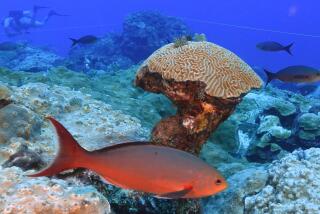Rolls Royce, Vessels Become Habitat : Artificial Reefs Increase Fish Populace
- Share via
MIAMI — Environmentalists have sunk everything from rusty freighters to a Rolls Royce off the Florida coast, but until now they were uncertain whether man-made reefs actually increased the fish population or just drew them from other areas.
Now, however, biologists at the Florida Institute of Technology in Melbourne, Fla., have found evidence that artificial reefs do increase the total number of fish by providing shelter for larvae that would otherwise die.
The conclusion came from a 30-month experiment in the LooeKey National Marine Sanctuary off Big Pine Key, about 30 miles north of Key West.
Reef Arrays Placed
The researchers placed two circular arrays of table-sized artificial reefs made of plastic vinyl pipes and cinder blocks about one mile apart on the sandy sea bottom.
After a year, the reefs had stabilized and the fish population--primarily snapper--had moved in. The biologists added another large artificial reef in the center of one group to simulate a natural reef system in which an artificial reef was introduced.
They left the other group undisturbed to serve as a control.
The biologists then monitored the fish population for another year to determine whether the overall number increased, or whether the fish were simply redistributed.
“We found that within a year we had more than doubled the number of fish that inhabited the whole system of reefs,” said William Alevizon, the FIT biology professor in charge of the project.
Meanwhile, the number of fish at the control site remained constant.
Some From Other Reef
“We know that some of them came from our other reef to live on our new artificial reef. That means there was more food and shelter available at the reef they left, and more opportunity for larval fish to grow there,” Alevizon said.
“The overall result seems to be that when you increase the number of reefs, you increase the number of fish.”
That conclusion is important to the commercial fishing industry. Japan already spends $60 million to $70 million a year on artificial reefs, but U.S. fisheries have been wary of them, Alevizon said.
“They were afraid that if the fish moved to artificial reefs, that would just deplete the stock on existing reefs,” said Alevizon.
Like natural reefs, the man-made reefs form a sort of backbone for marine animals, plants and corals to grow on.
Oversees Reef Program
“The only difference is the natural reefs out there started on lime rock outcroppings,” said Ben Mostkoff, who oversees Dade County’s artificial reef program in Miami.
Sport fishermen, scuba diving clubs and government agencies have been creating artificial reefs off the Florida coast since the 1950s.
The Dade program, one of the nation’s most active, adds a new reef about every 10 days. It has sunk old freighters, concrete cubes and even an old police barge to form new reefs, all thoroughly cleaned to prevent water pollution.
The freighter Mercedes, which earned fame by running aground and crashing into a Palm Beach swimming pool, was later sunk off Fort Lauderdale to form an artificial reef. Not to be outdone, Palm Beach County sank a Rolls Royce for its reef program.
A separate two-year study in progress at the University of Miami’s Rosenstiel School of Marine and Atmospheric Science will examine what size and shape of artificial reef fish prefer.
“We suspect that for the same amount of money, you may be able to put in something more efficient,” Alevizon said. The role of reefs in providing shelter for fish was graphically demonstrated at the conclusion of the FIT project. Biologists removed all the artificial reefs they had placed in the Looe Key sanctuary. “As we were pulling them out, the barracuda moved in. They must have eaten 200 or 300 of those snapper. Once the reefs were pulled out, those fish had nowhere to hide,” Alevizon said.
More to Read
Sign up for Essential California
The most important California stories and recommendations in your inbox every morning.
You may occasionally receive promotional content from the Los Angeles Times.












